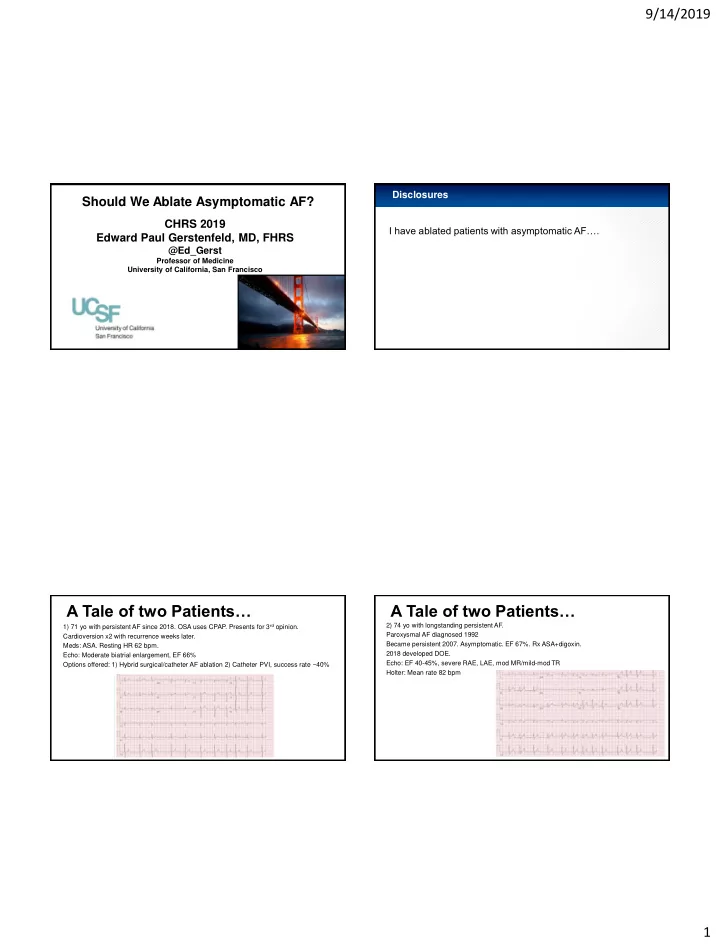

9/14/2019 Disclosures Should We Ablate Asymptomatic AF? CHRS 2019 I have ablated patients with asymptomatic AF…. Edward Paul Gerstenfeld, MD, FHRS @Ed_Gerst Professor of Medicine University of California, San Francisco A Tale of two Patients… A Tale of two Patients… 1) 71 yo with persistent AF since 2018. OSA uses CPAP. Presents for 3 rd opinion. 2) 74 yo with longstanding persistent AF. Paroxysmal AF diagnosed 1992 Cardioversion x2 with recurrence weeks later. Became persistent 2007. Asymptomatic. EF 67%. Rx ASA+digoxin. Meds: ASA. Resting HR 62 bpm. 2018 developed DOE. Echo: Moderate biatrial enlargement, EF 66% Echo: EF 40-45%, severe RAE, LAE, mod MR/mild-mod TR Options offered: 1) Hybrid surgical/catheter AF ablation 2) Catheter PVI, success rate ~40% Holter: Mean rate 82 bpm 1
9/14/2019 AFFIRM ➢ 4060 pts randomized to rate vs. rhythm control Why not to ablate asymptomatic ➢ Enrolled 1996-1999. Followed for mean 3.5 years AF… Assumption: truly asymptomatic Wyse et al. N Engl J Med. 2002 Dec 5;347(23):1825-33. AFFIRM – Predictors of Survival 2
9/14/2019 CABANA Trial Design Primary Endpoint (Death, Disabling Stroke, Serious Bleeding, or Cardiac Arrest) (ITT) Enroll patients with new onset or Ablation Therapy (1108) under-treated paroxysmal, Primary ablation: persistent, or longstanding • PVI/WACA persistent AF who warrant therapy Ancillary ablation: • Linear lesions • CFAE Key Inclusion Criteria R • 65 years of age Anticoagulation 1:1 • <65 years of age with 1 CVA/CV risk factor Drug Therapy (1096) •Eligible for ablation and ≥2 • Rate Control or rhythm or rate control drugs • Rhythm Control • Anticoagulation No Exclusion Criteria Identified Packer D. et al JAMA. 2019;321(13):1261-1274. Packer D. et al JAMA. 2019;321(13):1261-1274. AF Ablation Complications Estimates of All-Cause Mortality Risk (ITT) Complications Complications <25 Operator Volume >50 <50 >100 Hospital Volume Deshmuk et al. Circulation 2013;128:2104-2112 Packer D. et al JAMA. 2019;321(13):1261-1274. 3
9/14/2019 CTA of L MCA Stroke After PVI (HCM) • 150 patients with persistent AF (mean 13 mos) • Repeat ablation in 73% • 1 ° end point: freedom from asx or sx AF lasting >30s 8.5%/year recurrence 74% 65% Why Not to Ablate Asymptomatic AF ➢ You can’t help an asymptomatic patient feel better So why consider ablating asymptomatic AF… ➢ Complications in an asymptomatic patient would be devastating ➢ Recurrences after ablation for persistent AF not uncommon; multiple procedures may be required ➢ Zer o prospective data support mortality benefit 4
9/14/2019 AF-Mediated Cardiomyopathy CASTLE AF ➢ 67 pts with baseline EF ≤ 50% and “ controlled ” ventricular rate (<90 bpm) 80 70 57% 60 50 44% LVEF 40 30 20 10 0 Primary endpoint: All-cause death or unplanned hospitalization LVEF Baseline LVEF Follow up due to worsening of heart failure ➢ LV EF increased by > 5% in 82% patients ➢ LV EF normalized to ≥ 55% in 72% patients Marrouche et al. NEJM 2018 378(5):417.427. Gentlesk et al. JCE 2004. Overall Mortality CHF Trials: Total Mortality 13.4% 100 80 25.0% Mortality (%) 60 36.1 28.9 24.6 25 40 20.4 9.8 13.4 7.2 20 Control 0 Intervention Marrouche et al. NEJM 2018 378(5):417.427. 5
9/14/2019 Primary and Secondary Outcomes CABANA: Patient Randomization (Treatment Received)* Subjects 2204 Ablation Therapy Drug Therapy Ablation Drug Hazard Ratio P- 1108 1096 (N = 1307) (N = 897) (95% CI) Value Ablated Drug Treated Primary Outcome 92 (7.0%) 98 (10.9%) 0.67 (0.50, 0.89) 0.006 1006 (90.8%) 1092 (99.6%) repeat ablation 215 (19.4%) rhythm control 953 (87.2%) rate control only 126 (11.5%) Not ablated Secondary Outcomes Cross Over Ablated Crossovers 102 (9.2%) 301 (27.5%) All-cause mortality 58 (4.4%) 67 (7.5%) 0.60 (0.42, 0.86) 0.005 Completed FU Completed FU 1002 (90.4%) 48.9 mo 966 (88%) 48.2 mo Death or CV 538 (41.2%) 672 (74.9%) 0.83 (0.74, 0.94) 0.002 hospitalization * Withdrew <3 years *pre-specified Packer D. et al JAMA. 2019 Apr 2;321(13):1261-1274. Primary Endpoint Sub-group Analysis All-Cause Mortality, Disabling Stroke, 1 year 3 years Serious Bleeding, Cardiac Arrest * Minority=Hispanic or Latino or non-white race 6
9/14/2019 STAR AF II - Primary Outcome STAR AF II AF Burden • Documented AF > 30 seconds after one procedure with or without AAD p=0.15 59% 48% 44% Verma et al N Engl J Med. 2015 May 7;372(19):1812-22 Verma et al N Engl J Med. 2015 May 7;372(19):1812-22 Reasons to consider ablating asymptomatic AF: ➢ Randomized trial data only extend for 3-5 years. No data on 20-30+ years with AF. ➢ Patients with AF who underwent ablation in CABANA had lower mortality over only 3.5 years. ➢ For young AF patients, future risk of LA dilatation -> MR -> CHF. May be too late to address AF later. Early ablation better success. N=309 N=583 N=768 N=378 ➢ Association of AF with dementia may be modifiable Leong-Sit et al. Circ Arrhythm Electrophysiol. 2010;3(5):452-7. 7
9/14/2019 HRS/EHRA/ECAS 2017 Atrial Fibrillation Consensus Statement When is it appropriate to consider ablation for asymptomatic AF*? ➢ Young age (< ~60 years old) ➢ Paroxysmal or recent persistent (<1 year) AF (echo surrogate mild-mod LAE) ➢ Tachy or AF-mediated cardiomyopathy ➢ Tachy/brady with conversion pauses otherwise requiring pacemaker ➢ High risk occupation (pilot) with AF ∗∗ A decision to perform AF ablation in an asymptomatic patient requires additional discussion with the patient because the potential benefits of the procedure for the *After a thorough discussion of the risks/benefits patient without symptoms are uncertain Thank you A healthy 50 yo athletic patient presents with recent onset asymptomatic, persistent AF. AF recurs 2 weeks after CV. She has normal LV function, mild LAE. I would: A) Pursue a rate control strategy B) Try cardioversion + AAD C) Refer for standard catheter ablation D) Refer for PVI + LAA isolation 8
9/14/2019 42 yo Commercial Airline Pilot AF Onset R I P V LSP V C S R A First Recurrence AF – Post Blanking* (ITT) Packer D. et al Heart Rhythm Late Breaking Clinical Trials 2018 *Using CABANA Monitors 9
9/14/2019 Adverse Events in CABANA 10
Recommend
More recommend